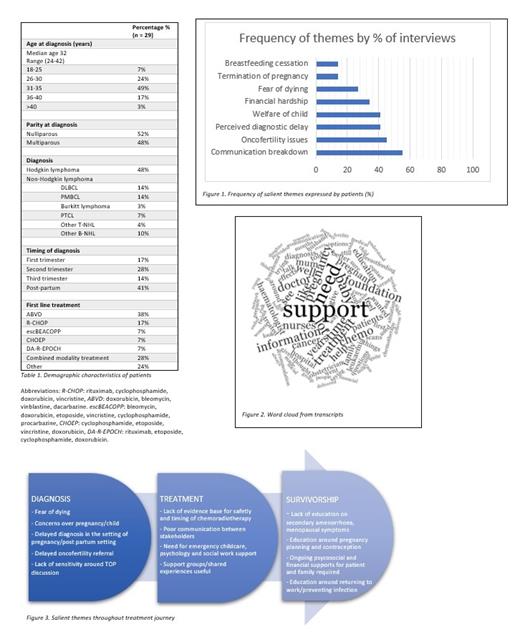Abstract
Background: Lymphoma in pregnancy is a rare and challenging diagnosis that complicates approximately 1:6000 pregnancies. Diagnostic delay occurs frequently, as lymphoma-related symptoms may be mistakenly attributed to the pregnancy itself, and diagnostic investigations postponed or omitted. Lymphoma in pregnancy poses a series of unique therapeutic, social, and ethical challenges to the patient, her family, and the medical professionals involved. This is largely due to a paucity of published management guidelines, with current evidence based on modest case series and expert opinion. In this study we endeavoured to understand women's lived experiences during this challenging time. We performed semi-structured interviews with women previously treated for lymphoma in pregnancy, to identify both gaps in care delivery and valued interventions with the aim of informing future models of care.
Methods: We retrospectively identified patients from twelve sites in Australia and New Zealand aged ≥18 years of age diagnosed with Hodgkin (HL) or non-Hodgkin lymphoma (NHL) during pregnancy or within 12 months postpartum, between 1 January 2009 and 31 December 2020. Baseline demographic characteristics, treatment details, and outcomes were collected, and semi-structured interviews were conducted via telephone with those who provided informed consent. Thematic analysis was performed using QSR Int NVivo 12 Pro (March 2020, USA) to quantify salient themes. The initial 5 transcripts were independently coded by two investigators who then reached a consensus on pre-determined codes. These codes were applied to the rest of the transcripts by one coder. The frequency of pre-determined themes was determined via descriptive statistics.
Results: A total of 29 women were interviewed. Baseline demographic characteristics are documented in Table 1. The majority were diagnosed during pregnancy (14%, 28% and 17% in the 1 st, 2 nd and 3rd trimesters respectively), while 41% were diagnosed post-partum. HL was the most frequent diagnosis (48%) followed by diffuse large B cell lymphoma and primary mediastinal lymphoma (14% each). More than 90% of women received chemotherapy with 28% receiving combined modality chemoradiotherapy. Sixty-nine percent commenced chemotherapy during pregnancy (17%, 28% and 14% in the 1 st, 2 nd and 3rd trimesters respectively) and 41% commencing postpartum. In the 28% of patients who received radiotherapy, this was administered post-partum.
A summary of themes identified and their frequency across the 29 transcripts are shown in Figures 1-3. Diagnostic delay attributed to pregnancy was reported by 41%. 21% of the women reported fatigue, breathlessness, weight change and musculoskeletal pain, which they felt healthcare practitioners found difficult to interpret in the context of pregnancy/postpartum period. Women recalled that their chief concerns at diagnosis were the welfare of their unborn child (41%) and a fear of dying (27%). Over half of the women (55%) reported perceived communication breakdown between health practitioners and patients. They also felt there was a lack of sensitivity in discussions around fertility preservation (45%), teratogenicity of treatment (31%), termination of pregnancy (14%) and cessation of breast-feeding (14%). Valued interventions included financial/logistic assistance from charity organisations (48%), a personal support network (45%), clinical psychology referral (31%) and emergency childcare (10%). Patients also found shared patient experiences (31%) and support groups (17%) beneficial in their treatment journey.
Conclusion: To our knowledge this is the first report capturing the lived experiences of survivors of lymphoma during pregnancy. This provides us a unique opportunity to consider our management, psychosocial supports, and delivery of care to meet the needs of these women. Areas for development in future care models include increased patient advocacy, educational materials, economic, psychosocial, and childcare supports. Above all, there is scope for improved, tailored communication between health practitioners and patients, with sensitivity around embryotoxicity, pregnancy termination and adverse outcomes to foster autonomy, build trust and improve maternal wellbeing.
Greenwood: Jazz Pharmaceuticals: Membership on an entity's Board of Directors or advisory committees; Servier: Membership on an entity's Board of Directors or advisory committees, Research Funding; Pfizer: Membership on an entity's Board of Directors or advisory committees; Amgen: Membership on an entity's Board of Directors or advisory committees, Research Funding. Gangatharan: Astrazeneca: Other: Educational Conference Funding. Hamad: Novartis: Membership on an entity's Board of Directors or advisory committees, Speakers Bureau.


This feature is available to Subscribers Only
Sign In or Create an Account Close Modal